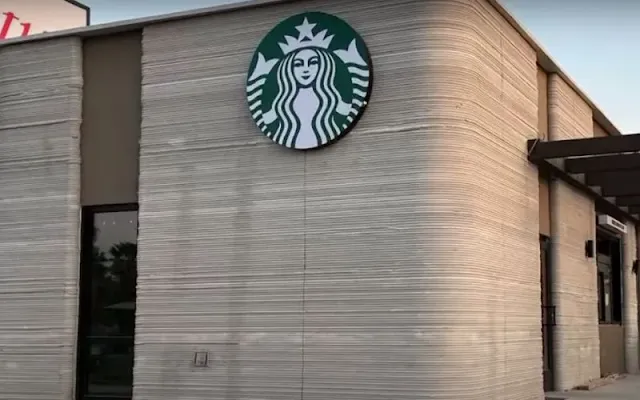 |
| A Starbucks coffee shop constructed entirely using 3D-printing technology. |
Robot-Built Starbucks Emerges in Texas as 3D-Printed Architecture Gains Ground
DECK
Brownsville hosts the nation’s first 3D-printed Starbucks café; part of a wider trend reshaping construction with machines and cement.
KEY FACTS
What: A Starbucks coffee shop constructed entirely using 3D-printing technology.
-
Where: Brownsville, Texas.
-
When: Built between late 2024 and early 2025; expected to begin operations on April 28.
-
Why: A growing national embrace of robotic and 3D-printed construction solutions.
-
How: A robotic printer extruded layers of a concrete-like material to create the building’s frame.
-
Who: Spearheaded by Germany’s Peri 3D Construction, using a Cobod BOD2 printer.
SITUATION SNAPSHOT
In the quiet border town of Brownsville, a sleek, ribbed concrete structure now stands where empty land once lay—a Starbucks like no other. Designed and printed by robotic arms, the building looks both futuristic and utilitarian, a symbol of how fast tech is reshaping America’s built environment.
 |
| A robotic printer extruded layers of a concrete-like material to create the building’s frame. |
WHAT WE KNOW
The 1,400-square-foot coffee shop is the first Starbucks in the U.S. built using large-scale 3D printing. Construction began in late 2024 using a Cobod BOD2 robotic printer, which extruded a cement-based mix layer by layer following digital design instructions. Once the printing concluded, conventional crews completed the job by installing windows, the drive-thru canopy, and interior fixtures.
Though Starbucks has yet to provide an official launch date, a local outlet, Brownsville Today, has reported that the location is scheduled to open for business on April 28. According to a public licensing document filed in 2023, the project’s estimated budget approached $1.2 million, though final costs remain unconfirmed.
WHAT’S NEXT
Locals and architecture enthusiasts alike await the official unveiling. The broader implications, however, are already visible: more 3D-printed buildings are expected to pop up nationwide as the technology becomes more cost-efficient and scalable. Starbucks may be testing the waters here for potential replication.
VOICES ON THE GROUND
“We’ve never seen anything like this in our city,” said one Brownsville resident watching construction progress.
A source close to the project noted, “It’s not just about aesthetics—it’s about speed, cost, and innovation.”
Starbucks, for now, has commented only that the site will open “soon.”
CONTEXT
The café is just the latest entrant in America’s fast-evolving 3D construction scene. Texas in particular has become a hub for innovation: the firm Icon, for instance, has printed residential neighborhoods such as Wolf Ranch and the Community First! Village, aimed at affordable and sustainable living. Peri 3D Construction, the firm behind the new Starbucks, previously built Europe’s largest 3D-printed structure and now appears to be extending its reach across the Atlantic.
The distinctive ribbed texture of the Starbucks walls—a byproduct of the layer-by-layer printing technique—serves as a visual reminder of how radically building methods are changing.
REPORTER INSIGHT
Standing next to the structure, it’s easy to forget that no traditional bricks were ever laid here. Instead, a machine poured out the skeleton of the future, one layer at a time. This Starbucks might serve up espresso—but it also brews a fresh vision of how America might build in the years ahead.





 Get it on Google Play
Get it on Google Play



0 Comments